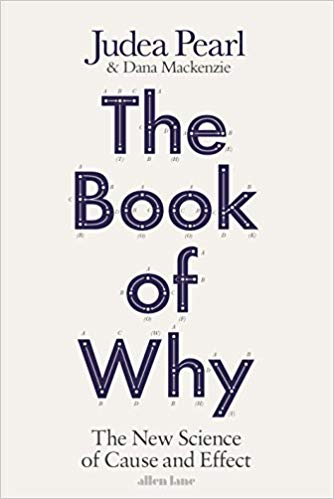The Book of Why: The New Science of Cause and Effect
By Judea Pearl and Dana MacKenzie
Published 2018
ISBN: 978-0-465-09760-9
–Review by Douglas Balzer
The title of this book is brilliant. The Book of Why. Why? A single word question that brings with it profound implications and deep frustration. Still, it is a question we are innately drawn to even from childhood. Coming from a three-year-old, who has discovered the sheer joy of annoying people with the word, we are all at some point have fundamental questions about how things came to be the way they are, or how they should be.
So, how can a book on causation and correlation help us in our quest? No matter what your training, vocation or present environment the background question is why. Think about asking yourself about what your underlying assumptions are and how you draw your conclusion concerning causation and correlation. It is all about a relationship of how various factors lead to different results. Why?
Pearl and MacKenzie in this collaborative work providing a narrative of the history of Why, or the history of cause and correlation. The book allows us the opportunity to explore the world that is and could have been.
Pearl and Mackenzie brilliantly push back and breaks down the barrier of the dominant assumption surrounding the ideology that “correlation does not imply causation.” They draw us into the discussion of dealing with cause and effect by debunking some of the basic “truth” in mathematics.
It is a truism that the world is brutal when it comes to ideologies and in many cases, the louder voices win. So, it has been with the research in the arena of cause and correlation. The idea was causation could not be proven it could not be represented as data. Therefore, the science what considered invalid and ridiculed. Times have changed, and the causation principle is winning the day. For example, a causal link between smoking and cancer was acknowledged by the Surgeon General in 1964.
Data alone can mislead when causality is neglected. The example of the causal link between smoking and cancer was a hard fought battle to get recognized. Why? The data and its interpretation. It is a generally acknowledged truth that if you really want to understand the root cause of something, you’re going to have to collect data about it. Get to the facts, but when facts are not enough data does not tell the whole story. So, a note of caution must be expressed: unless data is properly analyzed, it can be wildly misinterpreted.
The crux of Pearl and Mackenzie’s work is the development of what they call the Ladder of Causation. I found it to be helpful in when doing research.
The first rung of the Ladder of Causation is concerned with association and probability.
By nature, we are inclined to look at the world around us and start making connections. It’s that sort of thinking that stands on the first rung of the Ladder of Causation. Interestingly, though we’re programmed to do it almost from birth, the machines we’ve created to help us in our daily lives still can’t get close.
The second rung of the ladder is intervention.
Causation requires not just watching the world but changing it. It’s only humans that do this on a regular basis. The second rung of the ladder is typified by the question “What if we do . . . ?” It’s the “do” part that’s important. Unlike the passive first rung, the second rung is characterized by actively influencing outcomes. One of the best ways to test the effect of something is to conduct a controlled experiment.
These kinds of controlled experiments are hardly new – they’re actually reported in the Bible. In the story of Daniel, the Babylonian King Nebuchadnezzar sought out some of the captured nobles of Jerusalem for his court, as was customary. This involved educating them in the elite Babylonian diet of rich meats and wine. However, in accordance with Jewish dietary laws, some of the Jewish boys would not eat the meat.
The third and final rung of the ladder involves getting to grips with counterfactuals.
The third rung on the ladder is unique to humans: it’s the ability to imagine how different interventions can lead to different outcomes. One common way of putting this imagination into practice is to use counterfactual models. In other words, to picture what would happen if another action were taken. Understanding the three rungs of the Ladder of Causality is crucial in helping us understand causal questions.
Knowing that causation exists is only half the battle. What really matters is establishing why one thing causes another. Mediators are on the third rung of the Ladder of Causality because they go hand in hand with counterfactuals. We could ask, for instance, “Would the fire have triggered the alarm if not for the smoke?”
Mediators are useful things, then, but we can run into trouble if we start misidentifying them. The classic example is scurvy, the disease that ravaged sailors for centuries. We know now that it can be prevented by taking vitamin C. However when it was noticed in 1747 that citrus fruits counteracted scurvy, people assumed that it was the fruits’ acidity that was doing the work. After all, vitamins weren’t discovered until 1912.
Identifying mediators is critical as the example illustrates. Pearl and Mackenzie present several clear examples in the text where mediators were initially misidentified and later corrected. Now, there is a section on AI and the ability and inability to ask or understand why. It is the bonus section so to speak.
The message of the book simply stated is – in our endeavors to understand exactly how causation works have negatively affected our research in all areas and as a result has hindered advances in our progress scientifically, as well as, from another perspective, socially and culturally. Maybe even spiritually.

